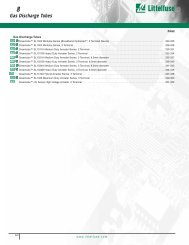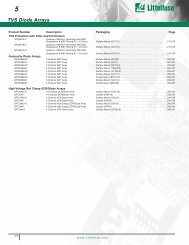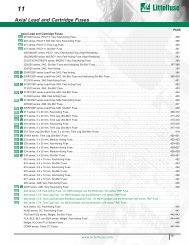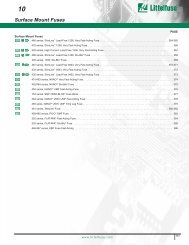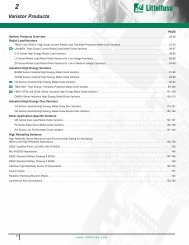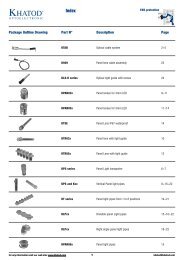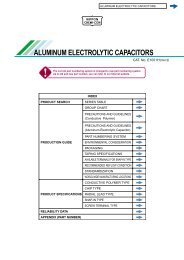Introduction to Circuit Protection
Introduction to Circuit Protection
Introduction to Circuit Protection
You also want an ePaper? Increase the reach of your titles
YUMPU automatically turns print PDFs into web optimized ePapers that Google loves.
<strong>Introduction</strong> <strong>to</strong> <strong>Circuit</strong> <strong>Protection</strong><br />
Fuseology<br />
Fuse Selection Guide<br />
A<br />
B<br />
C<br />
D<br />
E<br />
F<br />
6<br />
ip<br />
ip<br />
i p<br />
i p<br />
i p<br />
i p<br />
OR<br />
t t<br />
t<br />
1<br />
t<br />
t<br />
t<br />
t<br />
ib<br />
CHART I<br />
WAVESHAPES FORMULAS<br />
FUSEHOLDER SELECTION GUIDE<br />
i = k<br />
I 2 t = i p2 t<br />
i = i p-kt<br />
I 2 t = (1/3)(i p2 + i pi b+ i b2 )t<br />
i = i p sin t<br />
I 2 t = (1/2)i p2 t<br />
I 2 t = (1/3)i p2 t<br />
i = kt2 OR i = ip(1-kt) 2<br />
I2t = (1/5)ip2 t<br />
i = i pe –kt )<br />
I 2 t ≅ (1/2)i p2 t 1<br />
RERATING: For 25°C ambient temperatures, it is recommended that<br />
fuseholders be operated at no more than 60% of the nominal current<br />
rating established using the controlled test conditions specified by<br />
Underwriters Labora<strong>to</strong>ries. The primary objective of these UL test<br />
conditions is <strong>to</strong> specify common test standards necessary for the<br />
continued control of manufactured items intended for protection against<br />
fire, etc. A copper dummy fuse is inserted in the fuseholder by<br />
Underwriters Labora<strong>to</strong>ries, and then the current is increased until a<br />
certain temperature rise occurs. The majority of the heat is produced by<br />
the contact resistance of the fuseholder clips. This value of current is<br />
considered <strong>to</strong> be the rated current of the fuseholder, expressed as 100%<br />
www.littelfuse.com<br />
Step 3 — Examine the I 2 t rating data for the PICO ® II, 125V, very fastacting<br />
fuse. The part number 251001, 1 ampere design is rated at 0.256<br />
A 2 Sec., which is the minimum fuse rating that will accommodate the<br />
0.2327 A 2 Sec. value calculated in Step 2. This 1 ampere fuse will also<br />
accommodate the specified 0.75 ampere normal operating current,<br />
when a 25% derating fac<strong>to</strong>r is applied <strong>to</strong> the 1 ampere rating, as<br />
previously described.<br />
TESTING: The above fac<strong>to</strong>rs should be considered in selecting a<br />
fuse for a given application. The next step is <strong>to</strong> verify the selection by<br />
requesting samples for testing in the actual circuit. Before evaluating the<br />
samples, make sure the fuse is properly mounted with good electrical<br />
connections, using adequately sized wires or traces. The testing should<br />
include life tests under normal conditions and overload tests under fault<br />
conditions, <strong>to</strong> ensure that the fuse will operate properly in the circuit.<br />
CHART II<br />
PULSE CYCLE WITHSTAND CAPABILITY<br />
100,000 Pulses Pulse I 2 t = 22% of Nominal Melting I 2 t<br />
10,000 Pulses Pulse I 2 t = 29% of Nominal Melting I 2 t<br />
1,000 Pulses Pulse I 2 t = 38% of Nominal Melting I 2 t<br />
100 Pulses Pulse I 2 t = 48% of Nominal Melting I 2 t<br />
Number of Pulses<br />
100000<br />
10000<br />
1000<br />
100<br />
10% 100%<br />
Pulse I 2t / Average Melting I 2t<br />
Note: Adequate time (10 seconds) must exist between pulse events<br />
<strong>to</strong> allow heat from the previous event <strong>to</strong> dissipate.<br />
of rating. Some of the more common, everyday applications may differ<br />
from these UL test conditions as follows: fully enclosed fuseholders,<br />
high contact resistance,air movement, transient spikes, and changes in<br />
connecting cable size (diameter and length). Even small variations from<br />
the controlled test conditions can greatly affect the ratings of the fuseholder.<br />
For this reason, it is recommended that fuseholders be derated<br />
by 40% (operated at no more than 60% of the nominal current rating<br />
established using the Underwriter Labora<strong>to</strong>ries test conditions, as<br />
previously stated).




